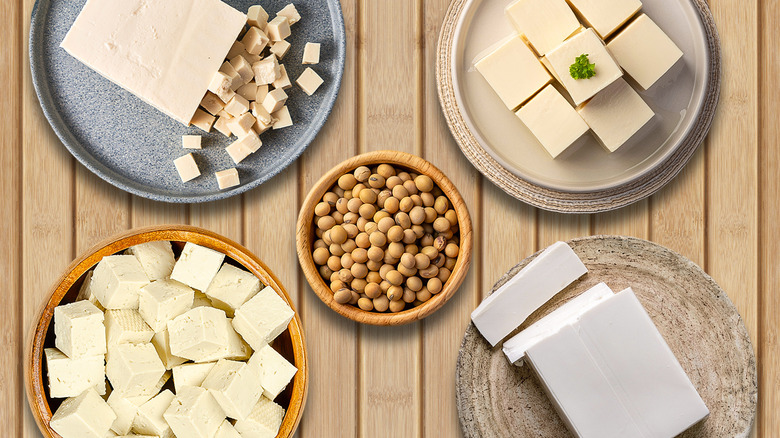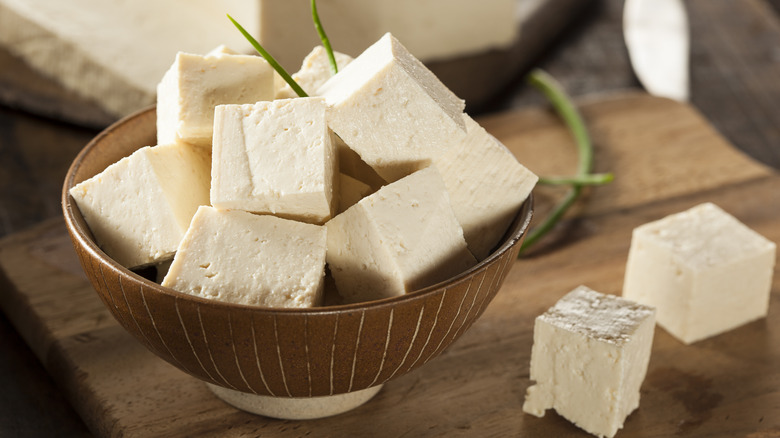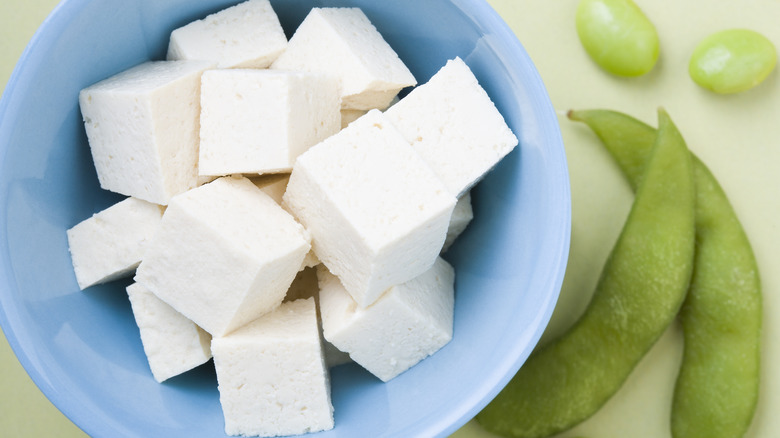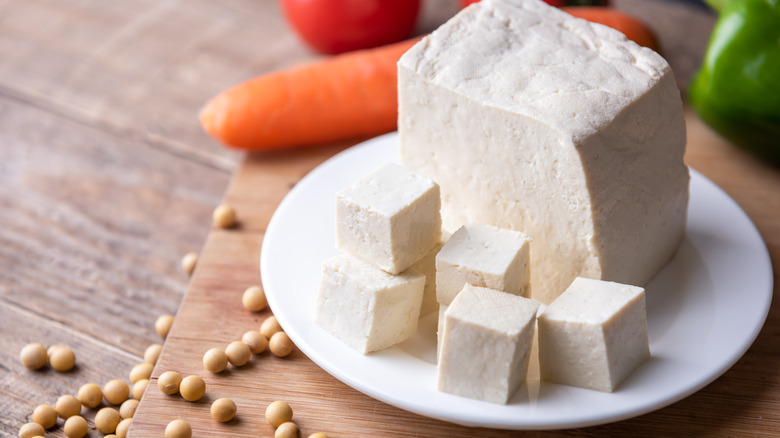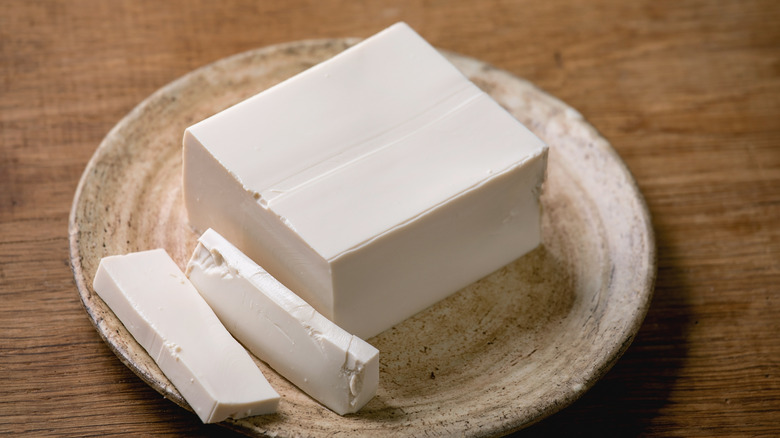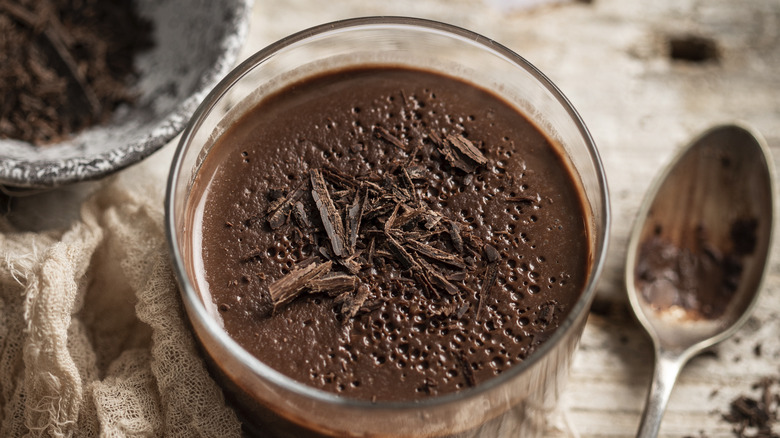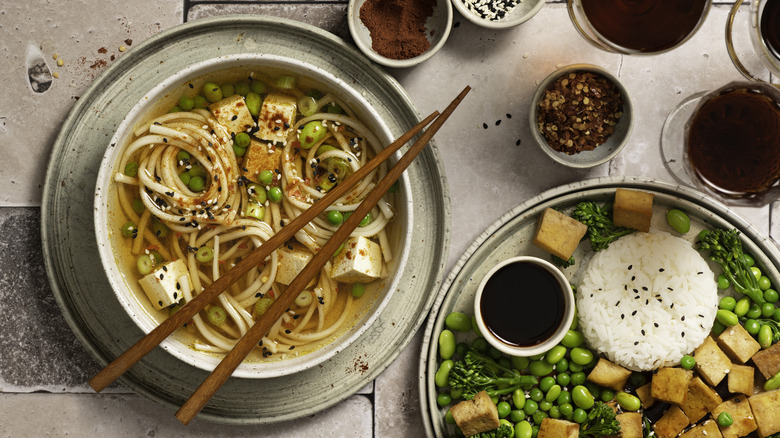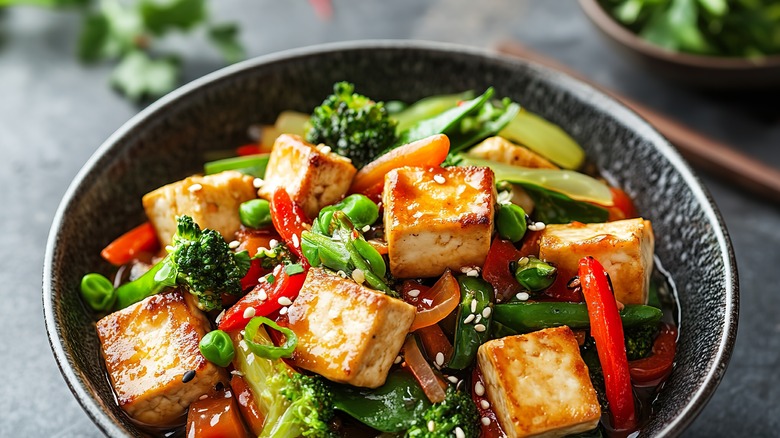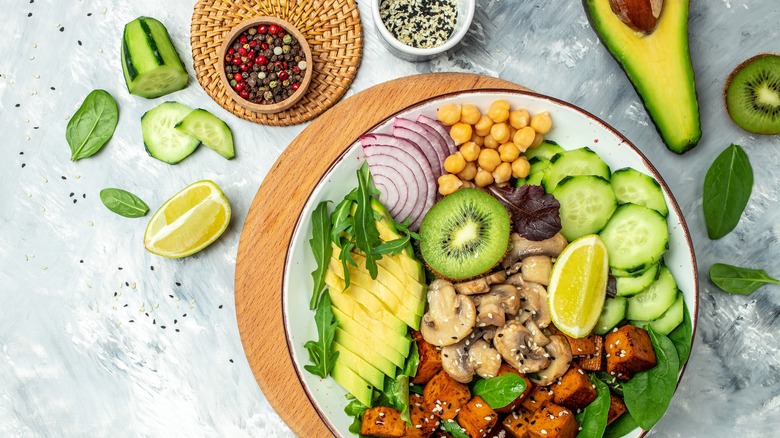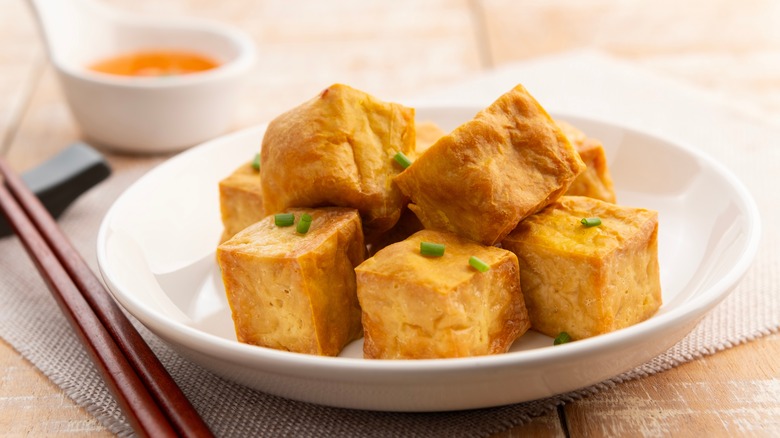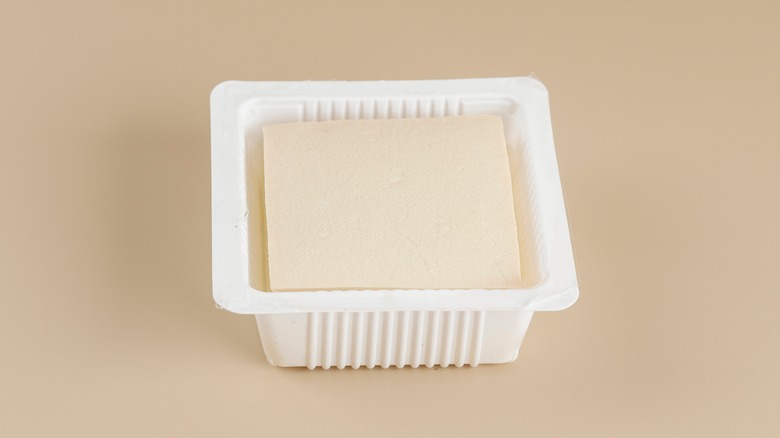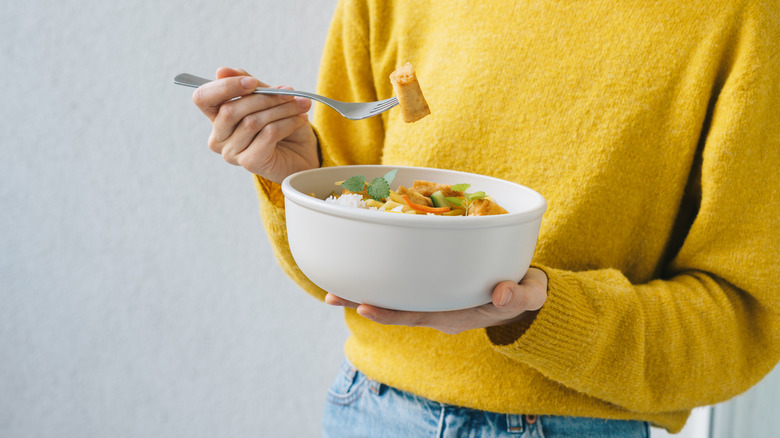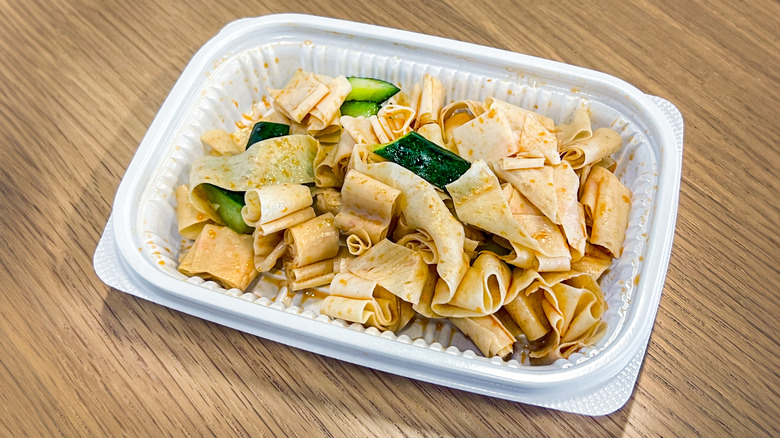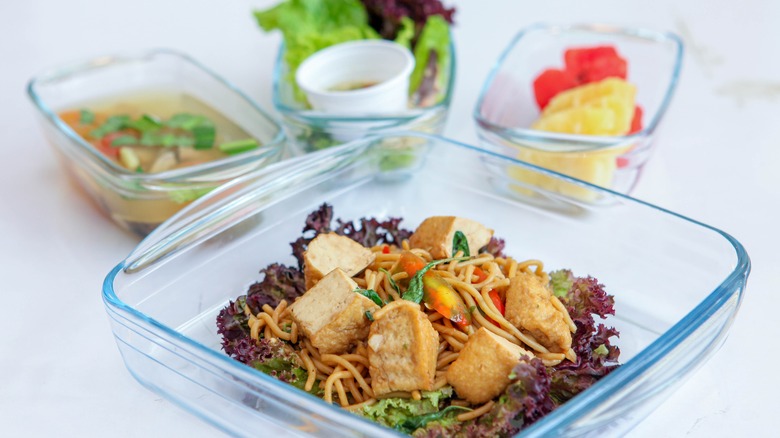The Definitive Guide To Every Type Of Tofu
We may receive a commission on purchases made from links.
Tofu has a reputation, but it is not a very good one. To be fair, it comes out of the package more or less flavorless, in a range of somewhat puzzling textures that many home cooks don't know what to do with. The truth is, tofu is less a food of its own (though it does contribute a good amount of vegan protein to the diet) and more a vehicle for flavor. Learning how to cook with it is an important skill for anyone trying out Meatless Mondays or just wanting to get more plant-based goodness in your life.
So how do you use tofu in the kitchen? Chowhound sat down with experts to create a comprehensive guide and discovered that tofu is much more than you think. "Many people think tofu is bland, but it absorbs flavors exceptionally well when marinated or cooked with spices," says Lisa Richards of The Candida Diet. "Tofu is also highly versatile, working in savory and sweet dishes, and can take on different textures depending on how it's prepared." In other words, you just have to know its secrets.
What is tofu?
Tofu is, let's face it, not the most appealing of foods when you pull it out of the container. More than that, it's just straight odd, what you might assume Soylent Green looks like before it gets dyed jade and turned into crackers on a conveyor belt. However, tofu is a pretty simple food, made of fermented soy (Glycine max), which is a member of the plant family.
Soybeans (also known as soy beans or soya beans) are widely available legumes. They grow on plants that look similar to peas, and also like peas, their mature form is a green pod containing a number of roughly kidney-shaped beans. You've probably seen them in their original form as edamame, often served whole and salted at Japanese restaurants. Most people wouldn't grow soybeans at home, although you could if you really love edamame.
The tofu production process
While soybeans are the main component, tofu is made of other ingredients as well. For that reason, and just to understand this ingredient as a whole, it's helpful to know a bit more about the production process. While it is relatively simple, it is probably beyond the purview of most home chefs, which is why we usually buy it in blocks at the grocery store.
Like any fermented product, tofu undergoes several stages during its manufacture. To make tofu, manufacturers dry, soak, crush, and then boil soybeans. Once the water turns to "milk," the solids are removed and coagulant is added to it to help separate the curds and whey. (This is much like the process of making cheese from dairy milk.) Once the curds form, they are removed and put into molds, where they continue to drain. When the tofu reaches the desired consistency (which is different depending on whether the tofu is silken, soft, medium, firm, or extra-firm), it is stored in water until ready for use.
A brief history of tofu
Tofu is more than 2,000 years old. It originated in China, most likely during the Han dynasty between 206 BCE and 220 CE. Though we can't know for sure, many believe it was created by accident, as cheese may have been. It has become an important part of Chinese culture, symbolizing health, happiness, simplicity, and celebration. Eventually, it reached Japan in roughly the 8th century BCE. From there, it spread around the world, becoming popular in Western culture sometime in the 1960s, though this was not its actual introduction to the United States; Benjamin Franklin had made a study of it much earlier.
Today, it has become one of the most popular proteins worldwide and is on par with meat and dairy in many Asian cuisines. In Japan, China, Korea, and Southeast Asia, tofu is a critical source of protein. In America and Europe, it serves as a meat substitute and a backbone of vegetarian and vegan cuisine.
Flavor of tofu
As for taste, tofu doesn't really have one of its own. At best, it tastes like a very mild version of soybeans, sometimes with a slightly sour or nutty twist. That's really not a problem, though, as tofu is usually flavored before cooking.
Indeed, when asked what their primary goal with tofu was, Alex Mazzucca and Cara Duerr, founders of the vegan restaurant Seed to Sprout, said "We would love people to know how easy it is to make delicious, and how incredibly versatile it is. It can take on so many flavor profiles, you really can't go wrong!" Yep: It's tofu's versatility, not its flavor, that makes it appeal to home cooks today.
"Many people think tofu is bland or rubbery, but that's a misconception," says Robert Smith, a private chef at the Culinary Collective. "Tofu is like a culinary chameleon: it absorbs flavors from whatever you cook it with. When prepared correctly, it can be deliciously rich and satisfying. The trick is in seasoning and cooking methods." Before touching on that, though, let's take a look at the five main kinds of tofu.
Silken tofu
Silken tofu is the softest, least set form. "Silken tofu is ideal for blending into smoothies, soups, or sauces, and is often used in desserts like puddings or as an egg substitute," explains Lisa Richards. In general, she says, "Its delicate texture makes it perfect for creamy dishes."
It's great for baking as well. You can sub it in for eggs at a ratio of ¼ cup blended silken tofu for every egg needed. This adds moisture and some protein without changing the flavor, according to Robert Smith. It is also great for muffins and other baked goods.
Because it blends so well, silken tofu is also a nice addition to creamy sauces and fillings in more savory dishes. You can cut it up into cubes to simmer in spicy or umami sauces, or you can simply heat up the block of tofu and pour a sauce over the top, then serve by the slice.
Soft tofu
"When it comes to soft tofu, I find it's best for dishes where you want that smooth, creamy texture," says Rena Awada of Healthy Fitness Meals. "I usually blend it into soups or sauces to add a velvety finish, which is perfect for a rich, comforting dish." Much like silken tofu, you can blend it into desserts, especially those where a bit more structure than silken is called for. Think chocolate mousse or cheesecake. Just note that soft and silken tofu are much more delicate than the firmer types. "I handle them gently," Awada says.
Also, don't be confused by the labeling of some brands. Mori-Nu, for instance, labels all of its tofu textures as "silken," perhaps to convey that they are smoother than brands that contain larger curds. So look for the grade of tofu elsewhere on the package; it should stand alone and be in the same place as "silken," "firm," etc. would be.
Medium tofu
Medium tofu is a little harder to find. It isn't readily available online, although you can often spot it in larger grocery stores or get it on Instacart. Often you'll see it labeled as "medium firm," which is the same thing. In general, medium tofu is a bit grainier than silken or soft tofu, with visible curds. However, it's easier to cut up than firm or extra firm tofu varieties, and its softer texture makes it a good choice for dishes where you want it to granulate, such as a "ricotta" cheesecake, which Alex Mazzucca and Cara Duerr like to make.
This consistency sits at the crossroads of the softer and firmer varieties. As such, it's a good choice if you want to keep tofu in your fridge at all times but need versatility. It's still soft enough to blend into a smoothie, but firm enough that you can cook it into savory dishes if you're gentle. This writer, for instance, likes it in fried rice or scrambles, either with or without eggs. It's also good for dishes that involve braising because it has some heft to it and won't get broken up by gentle stirring. Just note that if you want a tofu that can hold up to vigorous handling, you should go for a firmer texture.
Firm tofu
Firm tofu is getting into the savory realm for sure. "Firm and extra-firm tofu are my go-to for dishes that need some texture and bite," Rena Awada says. "I love using them in stir-fries since they hold their shape really well, even when they're tossed around with lots of veggies and sauce. They also work perfectly on the grill or in a skillet because you can get a nice crispy exterior without them falling apart." It's a great texture when you want tofu to be the star of a dish, she adds, because it has that chewy, meaty texture.
Firm tofu is also great for roasting, say Alex Mazzucca and Cara Duerr: "The firmer the tofu is, the more shape it will hold." Because of this, you can even cube it and put it on skewers, grilling or roasting it before topping a salad or bowl with extra protein.
Extra-firm tofu
"If you're looking for a meatier or crispier texture, go for the firmest you can find," recommend Alex Mazzucca and Cara Duerr. That's where extra-firm tofu comes in. Lisa Richards agrees. "Extra-firm tofu is great for stir-fries, grilling, or baking because it holds its shape well," she says. "It can also be crumbled into dishes like scrambles or used as a meat substitute due to its dense texture."
Note that firm and extra-firm tofu can hold a lot of water which may prove counterproductive to the cooking process. If you're diligent about getting all the water out of your tofu, you'll get a crispier result when frying. (And a less splatter-you-in-the-eye-with-hot-oil result as well.) You can easily do this by pressing your tofu, placing the unwrapped and drained block on a plate, wrapped in a towel, with another plate on top. Weight the top plate with a heavy crock or frying pan, which will squoosh the water (a technical term) out of the curd. When it stops draining, you're done. This will produce a decent amount of liquid, so make sure your bottom plate has a good lip.
Flavors that go well with tofu
Which flavors pair well with tofu depends somewhat on the consistency. For firm and extra firm, Robert Smith says to think of strong flavors: "Try soy sauce, miso, garlic, ginger, or spicy marinades. They pair wonderfully with earthy spices like turmeric and cumin, too." Rena Awada agrees. "These bold flavors seep into the tofu and turn it into something really tasty that can anchor a meal," she says. "I also love adding a bit of spice, like chili flakes or pepper, to give it an extra kick."
On the other hand, Smith says soft and silken forms of tofu "love gentle flavors like coconut milk, vanilla, or herbs. You can also blend them with citrus for a refreshing twist." Cocoa and fruit puree also work, Awada says. Because silken and soft tofu is so light, it has that airy feel that carries sweet flavors without overwhelming the dessert.
Easy tofu recipes for beginners
Any new ingredient can feel intimidating, so knowing where to begin is important. "Beginner-friendly tofu recipes include tofu stir-fries with vegetables and soy sauce, crispy tofu baked with a simple marinade, or tofu scrambles as an egg replacement," Lisa Richards says. "These dishes are quick, nutritious, and easy to customize." Or you could try baking it on parchment paper, as Alex Mazzucca and Cara Duerr recommend. "It's a good place to start because you can get it crispy without it sticking to the pan! We tend to keep it really simple with olive oil, sea salt, and nutritional yeast."
Rena Awada also recommends a stir-fry as another easy option. First, crisp small cubes by frying them on all sides in oil. Remove them, stir-fry veggies in the same pan, add the tofu back, and splash soy or teriyaki sauce over everything. Add noodles, et voilà! You're done.
If you're ready for a more elaborate recipe, consider crispy ginger-glazed tofu bowl or satay-style grilled tofu skewers. And if you're feeling a bit less adventurous, you can grill tofu pretty easily, so long as you've got the extra-firm variety on hand. As it absorbs sauces very well, this is a great way to inject your favorite marinade into more recipes.
How to choose the right tofu for your recipe
So, how do you go about choosing tofu for your recipes? "Choose tofu based on the texture you need: firm or extra-firm tofu for dishes that require structure, and soft or silken tofu for creamy or blended dishes," Lisa Richards recommends. "Pay attention to whether the recipe calls for pressing the tofu to remove excess moisture for better texture."
Rena Awada agrees that consistency is key. "Personally, if I'm looking to make a dish that needs a bit of structure, like a stir-fry or grilled tofu, I almost always go for firm or extra-firm tofu. They're easier to work with because they hold their shape well and soak up marinades like a sponge."
On the other hand, it's important to seek out softer tofu for creamy dishes, as firmer varieties can't create the same luscious effect. Note that not all desserts need to be creamy, though: "We LOVE to use tofu as the base of our baked ricotta cheesecakes," say Alex Mazzucca and Cara Duerr. "It adds so much good texture." On a final note, consider the packaging date, Robert Smith says. "Fresher tofu will taste better. And don't forget to check for organic options if you prefer that."
Health benefits of tofu
If you're motivated by science, then you'll be heartened to know that tofu has its backing. Eating tofu regularly can boost your heart health, lower your risk of cancer, help you build muscle, strengthen your bones, and make it easier to manage weight. It is, moreover, a complete protein, which means it contains all 9 "essential" amino acids (essential because your body cannot make them on its own, so you must get them from external sources). Note that other whole sources of soy, such as edamame and tempeh, also contain all nine amino acids, while processed soy often does not.
Be aware, however, that tofu also contains antinutrients. These are compounds that can make vitamins, minerals, and enzymes less accessible to your body. In small amounts, that's not a big deal, but you should be wary of subbing tofu in as protein at every meal. To be fair, most plant foods contain antinutrients, which is why a varied diet is so key to human health.
Storing tofu to last
Wondering how long tofu tastes good after opening? In order to answer that question accurately, we have to take a look at two different questions. The first is, how long does tofu last once you open the package, presuming you've done nothing else to it? About five days is the answer. You'll also want to submerge it in water, which prevents it from drying out in the fridge. Tofu doesn't actually have to spoil to become unusable; it will quickly cure to a brick-like consistency if it's uncooked and exposed to air, even inside a container.
The second question is, what about cooked tofu? The answer here is much the same. Cooked tofu will last between four and five days in the fridge, provided you put it in an airtight container. Make sure you put it away quickly after cooking it. The United States Department of Agriculture recommends you not leave food in the "danger zone" of 40 degrees Fahrenheit to 140 degrees Fahrenheit for more than two hours tops, as those conditions make rapid bacterial growth possible. We're talking exponential growth, with bacteria doubling in number every 20 minutes. Like, ew.
As for unopened packaged tofu, pay attention to the date. Ideally, you should use it by its best-by date, though these are, by nature, conservative. As long as they're not showing signs of spoiling, you can safely eat foods past their best-by date. With tofu, you'll know if it's going off, because the package will puff up and become firm from the pressurized gases within. If that happens, say bye-bye, tofu.
Nutritional information
Tofu contains a lot of nutritional benefits. Unfortunately for the vegetarian and vegan set, it is lower in protein than meat sources. For example, while 3.5 ounces of chicken contains 31 grams of protein, the same amount of tofu only contains eight grams, according to some sources.
However, due to its lighter nature, you can easily eat half a package of tofu (packages are usually 14 grams and are clock in pretty close to their labeled weight). Some back-of-the-napkin math brings your protein total up to about 18 grams. Add in some additional beans, and you're good. This doesn't even account for the fact that some sources say a 3.5-ounce serving can contain as much as 17 grams, so macronutrients will definitely vary by brand.
Plus, tofu has tons of vitamins and minerals. These include calcium (of which it contains 53% of your daily value), manganese (51%), copper (42%), as well as lower amounts of selenium, vitamin A, phosphorous, iron, magnesium, and zinc. If you choose tofu that is marinated, you may see some extra health benefits. For instance, miso tofu contains miso, a different type of fermented soybean, which is also a complete protein and contains lots of vitamins and minerals of its own. Sprouted tofu may also give you a health boost, as sprouted legumes are easier to digest, and their nutrients are more bioavailable (i.e. easier for the body to use).
